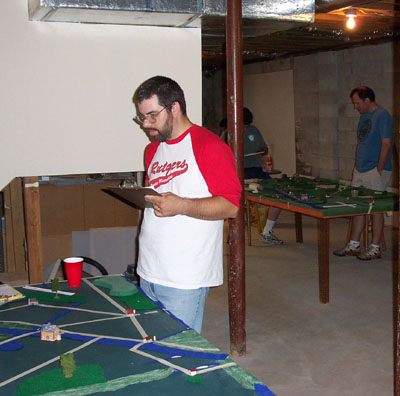 So much for the Treaty of Tilsit! On the night of June 23, 1812, the Corsican Ogre just invaded Holy Russia, and he seems to have brought most of Europe with him. Napoleon's concentrated around Kovno, where he crossed the Nieman River, although a flanking group is heading towards Bialystok, and a small flanking corp is heading towards Riga. There's probably even more coming...maybe. The good news is that you had anticipated such a move as early as 1811, and made preparations accordingly. The bad news is that it may not be enough to contain the invasion and drive the French out of Russia.
So much for the Treaty of Tilsit! On the night of June 23, 1812, the Corsican Ogre just invaded Holy Russia, and he seems to have brought most of Europe with him. Napoleon's concentrated around Kovno, where he crossed the Nieman River, although a flanking group is heading towards Bialystok, and a small flanking corp is heading towards Riga. There's probably even more coming...maybe. The good news is that you had anticipated such a move as early as 1811, and made preparations accordingly. The bad news is that it may not be enough to contain the invasion and drive the French out of Russia.
Ed, (the Czar, front and center) contemplates his position at Drissa. In the background, Dan (right) tries to figure out how to contain Fred and the numerous French units pouring across the Niemen.
Fortifications at Drissa are complete in accordance with your Prussian advisor's plan to retreat there and attack the French flank should Napoleon dare to press on eastward. Fortifications at Duneberg and Borisov? Hardly begun. However, your other Prussian advisor pronounces the Drissa defenses worthless--a point hard to argue---and advocates falling back eastwards. Worse, your two main commanders, Barclay and Bagration, are at odds how to defeat the invasion. Barclay pushes for a defensive withdrawal. Bagration is spoiling for a fight at the frontier.
You have roughly 300,000 organized troops to meet the invasion, plus another 50,000 in scattered garrisons, and another 50,000 recruited in training. Most of the organized troops are in a semi-circle from Shavli to Bialystok.
- Czar: Drissa
1st Corp: Shavli
2nd Corp: Svencionys
3rd Corp: Molodechno
4th Corp: Minsk
5th Corp: North at St. Petersburg (Constantine)
6th Corp: Lida-Kuznitska
7th Corp: Kovel
8th: Corp: Kovel-Lutsk
Corps Kaminski, Markoff, & Sacken: South towards Danube
Garrisons (divisions): Riga, Smolensk, Moscow
"Ready" Army Reserve: East towards Moscow-Tula
TERRAIN:
From Poland to Smolensk is somewhat barren wilderness. Beyond Smolensk, the land becomes more open and fertile.The Ukraine towards the south is especially fertile.
ATTRITION:
The Russians suffer no attrition. Those 100,000 are sufficient to make up any loss.
SUPPLY:
The Russians have no supply restrictions. They are always in supply as long as they can trace a "line of communications road" off the east, south, or north edges. If cut off, they may rely on Barrels, Cauldrons, Urns, and Haystacks.
Barrels, Cauldrons, Urns, and Haystacks: These represent supply depots. The Russians probably will not need them, but in case they do...
- Haystacks: 36" range along roads, 18" cross country (pro-rate for non-Open terrain).
Barrels and Caldrons: 24" range along roads, 12" cross country (pro-rate for non-Open terrain).
Urns (thin): 12" range along roads, 6" cross country (pro-rate for non-Open terrain).
Russians may NEVER move Barrels, Cauldrons, Urns, and Haystacks.
Russians may "burn" (destroy) the supplies IF French troops are within 6" of a depot.
- An infantry or cavalry unit spends a 1/2 move and rolls a MC. Pass: Burn, baby, burn! Fail: Intact.
Out of Supply:
All units: 1/2 move and -1 modifier for firing and -2 modifier fro melee.
All units: Take MC during "Check supply" Fail: drop one level (no roll again). Pass: OK.
Using supplies: A commander may voluntarily use (destroy) a supply depot IF his units are out of supply.
Haystack: 3d10 units are in suppply for one turn.
Barrel and Cauldron: 2d10 units are in suppply for one turn.
Urn (thin): 1d10 units are in suppply for one turn.
VICTORY
The goal is to contain the initial invasion and then toss the French out.
Villages west of Dneiper, south of Dvina rivers: 1 point each
Villages east of Dneiper, north of Dvina rivers: 2 points each
Towns west of Dneiper, south of Dvina rivers: 3 point each (not Minsk/Drissa/Kiev)
Towns east of Dneiper, north of Dvina rivers: 4 points each
Minsk, Drissa, or Kiev (town): 5 points each
Smolensk (city): 10 points
Riga (fortress): 25 points
Preventing French from exiting eastward off map: 25 points
More Snappy Nappy: The Russian Conflagration of 1812
-
Snappy Nappy Campaign Introduction
SN Rules Experiments: Pushing the Envelope
Preliminaries, Set Up, and Preparation
French Situation and Introduction
Russian Situation and Introduction
Orders of Battle: French and Russian
Snappy Nappy Rules Conventions
The Game From the Umpire's Neutral Perspective
French and Russian Messages in Chronological Order
History: The 1812 Invasion of Russia in a Nutshell
Large Campaign Map (slow: 101K)
Jumbo Campaign Map (monstrously slow: 877K)
Napoleon's Memoirs
Back to War Lore: The List
Back to Master Magazine List
© Copyright 2004 by Coalition Web, Inc.
This article appears in MagWeb.com (Magazine Web) on the Internet World Wide Web.
Other articles from military history and related magazines are available at http://www.magweb.com